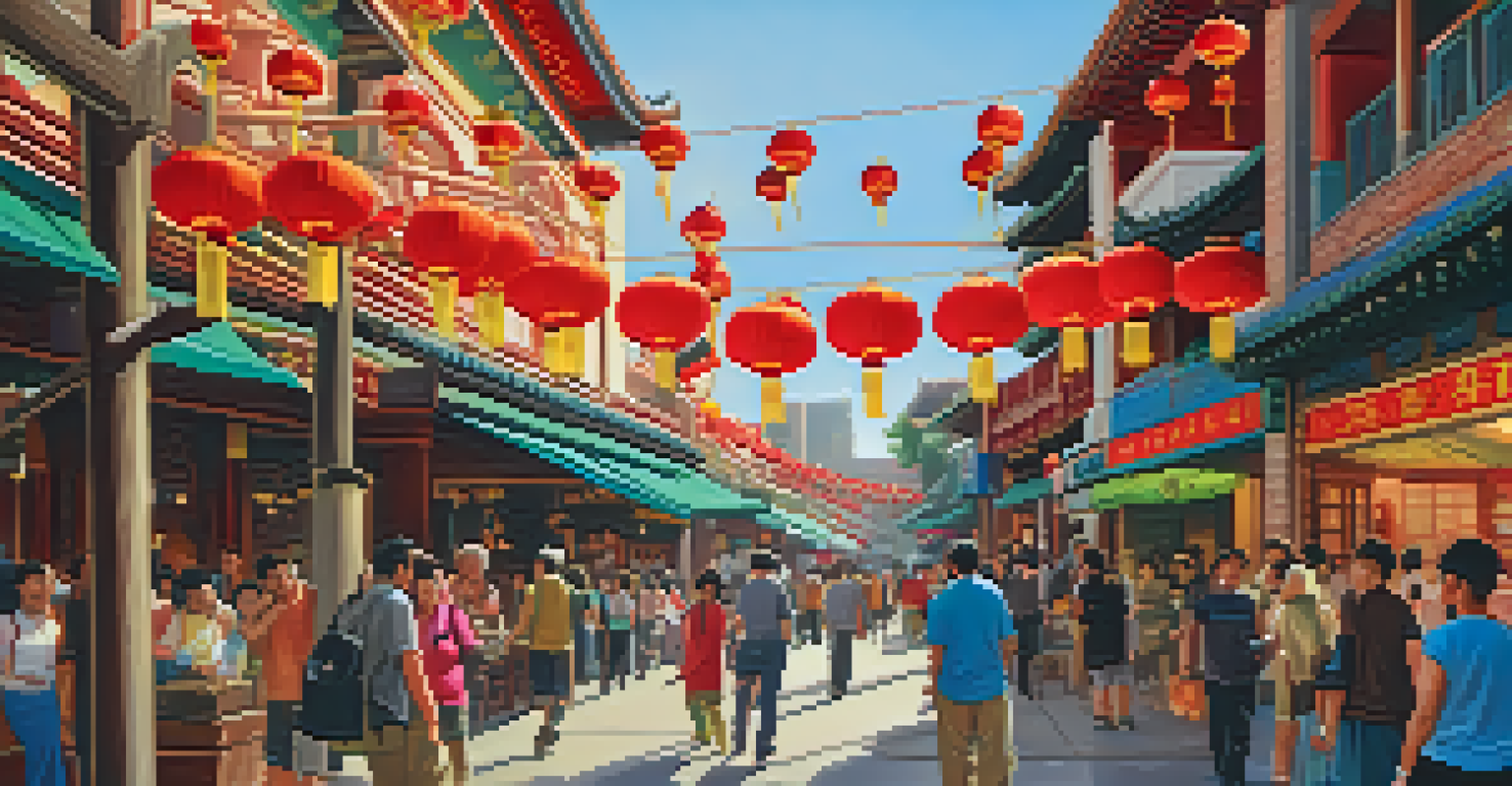Influential Cultures in Sacramento: A Historical Overview

The Indigenous Roots of Sacramento's Culture
Long before Sacramento became a bustling city, it was home to various Indigenous tribes, such as the Nisenan and the Miwok. These groups developed rich cultures deeply connected to the land and waterways, which continue to influence the region today. They practiced sustainable living, utilizing local resources for food, tools, and shelter, creating a legacy that resonates in the area’s environmental consciousness.
The land is sacred. It is not ours; it is a gift from our ancestors.
The Nisenan people, in particular, thrived along the banks of the American River, developing intricate fishing techniques and seasonal gathering practices. This relationship with nature laid the foundation for a deep respect for the environment that many Sacramento residents still uphold. Their stories and traditions remind us of the need to honor and preserve the cultural heritage of the land we inhabit.
Today, efforts are ongoing to recognize and celebrate the contributions of Indigenous cultures in Sacramento. Events, art installations, and educational programs help keep their history alive, ensuring that future generations understand the significance of these foundational cultures in shaping Sacramento’s identity.
The Gold Rush and Its Impact on Cultural Diversity
The discovery of gold in 1848 brought a tidal wave of settlers to Sacramento, transforming it into a melting pot of cultures and backgrounds. People flocked from various regions, including Europe, Asia, and South America, in search of fortune, leading to a significant increase in cultural diversity. This influx not only changed the demographics but also introduced new customs, languages, and cuisines that enriched the Sacramento community.

As miners and entrepreneurs settled in the area, they established businesses and communities that reflected their diverse origins. Chinatown, for example, emerged as a vibrant center for Chinese immigrants, showcasing unique traditions and culinary delights. The blending of these different cultures created a dynamic social fabric that has continued to evolve over the years.
Indigenous Heritage Shapes Culture
The rich traditions of Indigenous tribes like the Nisenan and Miwok continue to influence Sacramento's environmental consciousness and cultural identity.
The Gold Rush era laid the groundwork for Sacramento’s reputation as a hub of cultural exchange. This period serves as a reminder of how diverse populations can come together, fostering innovation and creativity that shape a city’s identity for generations.
The Role of the Railroad in Cultural Exchange
The arrival of the Central Pacific Railroad in the 1860s revolutionized transportation and commerce in Sacramento. This new infrastructure not only facilitated the movement of goods but also encouraged human migration, further enhancing the city's cultural landscape. People from various backgrounds were drawn to the opportunities that the railroad provided, leading to an even richer tapestry of cultures.
Diversity is not about how we differ. Diversity is about embracing one another's uniqueness.
With the railroad connecting Sacramento to major cities and distant regions, the city became a pivotal point for cultural exchange. Festivals, art exhibitions, and markets began to flourish, showcasing the unique traditions and products of incoming communities. This exchange of ideas and customs fostered a sense of unity among diverse groups, allowing them to share their heritage in a welcoming environment.
As a result, Sacramento transformed into a cultural crossroads, where different heritages could intermingle and thrive. The legacy of this era is still evident today, with a variety of cultural festivals and events that celebrate the city's rich diversity.
The Influence of Mexican Culture on Sacramento
Mexican culture has played a significant role in shaping Sacramento's identity, particularly following the Mexican-American War in the mid-19th century. Many Mexicans migrated to the area, bringing with them vibrant traditions, cuisine, and a strong sense of community. Today, this influence is palpable in various aspects of Sacramento life, from festivals to culinary offerings.
One of the most notable celebrations is Día de los Muertos, or Day of the Dead, which honors deceased loved ones through colorful altars and vibrant festivities. These events not only showcase Mexican heritage but also invite the entire community to participate, fostering understanding and appreciation across cultural lines. This blending of traditions highlights the importance of inclusivity in Sacramento’s cultural landscape.
Gold Rush Sparked Cultural Diversity
The influx of settlers during the Gold Rush transformed Sacramento into a melting pot of cultures, enriching the community with new customs and cuisines.
Additionally, authentic Mexican cuisine has become a staple in the city, with numerous restaurants offering traditional dishes that reflect the rich culinary heritage. From tacos to tamales, the flavors of Mexico are celebrated and enjoyed by locals and visitors alike, further enriching Sacramento’s diverse food scene.
The Rise of the Asian American Community
Sacramento's Asian American community has a deep-rooted history that dates back to the mid-1800s, when Chinese immigrants settled to work in mining and railroad construction. This early presence laid the groundwork for a flourishing Asian American population that would expand to include various cultures, such as Vietnamese, Filipino, and Indian communities. Their contributions have significantly shaped Sacramento’s cultural landscape.
The establishment of neighborhoods like Little Saigon highlights the vibrant culture and traditions of the Vietnamese community. This area is known for its bustling markets, authentic restaurants, and cultural festivals, which promote the rich heritage of Vietnamese Americans. Such neighborhoods serve as cultural hubs where people can experience the diversity of Asian traditions through food, art, and community events.
Moreover, the Asian American influence extends beyond cultural enclaves; it is seen in the city’s arts, education, and local politics. Sacramento has become a place where diverse voices can be heard, contributing to a more inclusive dialogue about community issues and identity.
African American Heritage and Its Contributions
The African American community has played a pivotal role in shaping Sacramento’s cultural identity, particularly during the Great Migration in the early 20th century. Many African Americans moved to Sacramento in search of better opportunities, contributing significantly to the city’s economy and cultural fabric. Their influence is evident in the arts, music, and community activism that continues to thrive today.
One of the most celebrated aspects of African American culture in Sacramento is its music scene. Jazz and blues have deep roots in the city, with venues and festivals dedicated to showcasing local talent. Events like the Sacramento Black Book Fair further highlight the contributions of African American authors and artists, providing a platform for their voices to be heard.
Modern Sacramento Celebrates Diversity
Today, Sacramento thrives as a cultural crossroads, with festivals and initiatives that promote inclusivity and celebrate the city's diverse heritage.
Additionally, community organizations play a crucial role in preserving and promoting African American history in Sacramento. These efforts ensure that the rich legacy and contributions of this community are recognized and celebrated, fostering a sense of pride and unity within the broader cultural landscape.
Modern Day Sacramento: A Tapestry of Cultures
Today, Sacramento stands as a testament to its diverse cultural heritage, with a vibrant community that continues to evolve. Festivals celebrating different cultures, such as the Sacramento Music Festival and the Sacramento International Film Festival, bring people together to share their unique traditions and experiences. These events not only entertain but also educate attendees about the rich tapestry that makes up the city’s identity.
Moreover, Sacramento's commitment to inclusivity is reflected in its local government and policies that support cultural diversity. Initiatives aimed at promoting equity and representation ensure that all voices are heard and valued, fostering a sense of belonging for residents from various backgrounds. This dedication to diversity is a key aspect of what makes Sacramento a welcoming place to live.

As Sacramento moves forward, its cultural landscape will undoubtedly continue to evolve, shaped by the stories and experiences of its residents. By celebrating its rich history and embracing new influences, Sacramento remains a dynamic city where diverse cultures coexist and thrive, creating a vibrant community for all.